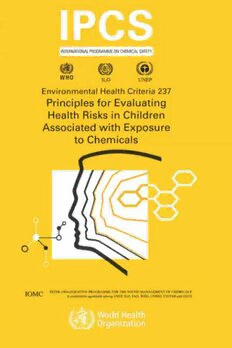
Principles for Evaluating Health Risks in Children Associated With Exposure to Chemicals (Environmental Health Criteria) (Environmental Health Criteria) PDF
351 Pages·2007·3.201 MB·English
Most books are stored in the elastic cloud where traffic is expensive. For this reason, we have a limit on daily download.
Preview Principles for Evaluating Health Risks in Children Associated With Exposure to Chemicals (Environmental Health Criteria) (Environmental Health Criteria)
Description:
This new volume in the Environmental Health Criteria (EHC) Series provides a systematic analysis of the scientific principles to be considered in assessing health risks in children; taking into account their unique susceptibilities. The terms children and child as used in this report include the stages of development from conception through adolescence. This new EHC builds on previous volumes addressing methodologies for assessing risks in children: EHC 30, Principles for Evaluating Health Risks to Progeny Associated with Exposure to Chemicals During Pregnancy (WHO, 1984) and EHC 59, Principles for Evaluating Health Risks from Chemicals During Infancy and Early Childhood: The Need for a Special Approach (WHO, 1986). The central focus of this volume is on the child (developing embryo, fetus, infant, etc.) rather than on a specific environmental agent, target organ, or disease. Thus, it addresses the difficult task of integrating all what is known about both exposure information, toxicity data, and health outcome at different life stages, which is especially challenging when data are limited for particular life stages (e.g., during pregnancy). The book will be useful to public health officials, research and regulatory scientists, and risk assessors.
See more
The list of books you might like
Most books are stored in the elastic cloud where traffic is expensive. For this reason, we have a limit on daily download.
